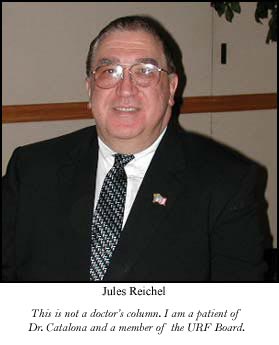One Man To Another: The Pathology Point of View
This is not a doctors column. I am a patient of Dr. Catalona and a member of the URF Board.

The Pathology Challenge
Prostate cancer begins as cellular mutations, or cancers, in the prostate, produced by our DNA/RNA (genetic) system for establishing cells.
The cause for the cancerous cells can be the environment, heredity, or normal aging.
Each abnormal cell can be anywhere in the prostate. As more cells begin to appear, some of them slowly grow into networks of tissue areas called lesions.
In time, the lesions may become large enough to be felt (palpated) by a doctor during a DRE (Digital Rectal Exam). These cancerous tissues are often called the tumor.
The gold standard for assessing the current status and future growth of prostate cancer is to evaluate the cancerous tissues under a microscope: either using biopsy samples prior to treatment, or by studying the whole prostate after surgery.
The medical specialist who does this tissue analysis is a Pathologist.
Dr. Dan Vick is such a doctor who works in St. Josephs Hospital Health Center: a community facility in my local region. Dr. Vick made the mistake of being seated next to me on a flight to Chicago. Much of the material for this article came from our later discussion; however, other material is also included.Prostate cancer is diagnosed based on needle biopsies of 4 to 6 different sites in the prostate. The urologist takes from 1 to 6 cores from each site.
Each core is about the size of a small thin sewing needle, and it is not difficult for these tiny cores to miss the lesion. The biopsy case examined by the pathologist contains all of these cores mounted in slides.
At Dr. Vicks hospital, the practice is to produce 4 slides for each prostate site. Each slide contains all of the cores from a site at increasingly deeper levels of the specimen. So if the urologist biopsied 6 sites, then Dr. Vick must study 24 slides.
It takes Dr. Vick about 1/2 to 3/4 of an hour to evaluate the biopsy case from a single patient after others have prepared the slides, and it takes him over an hour to evaluate the entire prostate after surgical removal.
Gleason Scoring: How Aggressive is my Cancer?
Aggressive refers to the ability of the cancer to spread, i.e. to become metastatic. Metastasis is the biggest reason that cancer is so greatly feared.
Dr. Vick, scores the cancer using a system called Gleason Scoring, after the work of Dr. Donald Gleason in 1974. Gleasons answer to assessing aggressiveness, which we call the Gleason Score (GS), has been under strong attack throughout its 30-year life, but the Gleason Score remains our standard for scoring prostate cancer. Gleason offered the following major insights:
1. The relative aggressiveness of prostate cancer is determined by analyzing the patterns of cells (called the architecture or the differentiation) in cancerous lesions.
Gleason selected 5 Gleason Grades (GG) according to the way that lesions looked under a microscope.
GG1 and GG2 are the most orderly architectures of tissue in a lesion, i.e. the least aggressive, GG3 is the most commonly seen, and GG4 and 5 have the more disordered architectures, i.e. they are the most aggressive and are rapidly losing their organized structure at an increasing rate.
2. The aggressiveness of the lesion is estimated by adding together two GGs.
One grade is for the predominant pattern, and the second grade is for the second-most predominant pattern. The Gleason Score (GS) is then determined by adding these two grade numbers together.
Gleason found that this arithmetic works because for prostate cancer the aggressiveness was always intermediate between the two grades.
For example, if the predominant portion of the lesion is GG4 and a lesser portion is GG3, then if we assumed that only the GG4 tissue mattered, the GS would be 4+4=8; or if we assumed that only the GG3 tissue mattered then the GS would be 3+3=6.
However, if we add the grades: GS: 4+3=7, we get a score of 7 which is intermediate between 8 and 6, and the system works as suggested.
Gleason arithmetic is so clear and simple that every patient thinks that he knows what it means. Too bad the reality is harder than that.
Few Gleason Scores Occur
Each Gleason Score is made up of two numbers (grades), and each number is between 1 and 5. So it is natural to assume that lots of different combinations of grades and scores will be reported.
However, the reality is that Gleason Scores of 6, 7 (made up of 3+4 or 4+3), and 8 account for well over 90% of all measured results.
That is, this whole complicated Gleason arithmetic breaks down to the above four numbers in the great majority of cases.
For patients and doctors these scores are interpreted as corresponding to cancer that is either moderately aggressive, or one of two forms of moderate-to-highly aggressive, or highly aggressive.
In addition, Dr. Vick told me that GS: 3+2=5 is the lowest recommended score to be reported on a needle biopsy. With that exception, everyone diagnosed on needle biopsy is given a minimum GS of 6. Indications of less aggressive areas appear only as comments in the report.
A Few More Difficult Issues of Scoring
Regions Not In the Gleason Score
Some of the lesion, often called a tertiary region, is not part of either of the two biggest regions that form the grades in the Gleason Score.
If, for example, the Gleason Score is calculated as GS: 3+2=5, but there is a tertiary region of GG4. how shall we calculate the Score?
Dr. Vick follows the rule of Dr. Epstein at Hopkins and replaces the lower grade, the GG2, with the GG4 from the tertiary region, since that is the more aggressive component.
Instead of reporting GS: 3+2=5, as you might expect, Vick reports GS: 3+4=7, a significantly more aggressive result.
High Grade PIN disease (HGPIN)
High grade prostatic intraepithelial neoplasia (HGPIN) is believed to be a cancer precursor that is under active study, but is not scored in the Gleason system.
Vick says that studies show that a man who has HGPIN will be diagnosed as having cancer 1/4 to 3/4 of the time during subsequent biopsy.
HGPIN is important because it is a warning of potential cancer elsewhere in the prostate. Some studies are in place to see if it is possible to prevent prostate cancer from developing if HGPIN is detected early enough. But HGPIN does not appear to increase PSA levels to aid its detection.
Most pathology work is done at low power magnification. However, analyzing HGPIN involves detailed cellular analysis, especially concerning the appearance of material in the nucleus of the cells . It requires high magnification. Vick again follows the rule of Dr. Epstein and comments on HGPIN only in his report and not in any score.
Accuracy Of The Scoring
Vick says studies show that between 13% and 36% of the post-surgical Gleason Scores (done on the entire prostate), are elevated compared to the estimate made at the time of biopsy. That information provides fairly good guidance when making a treatment decision but its certainly not perfect.
What does it All Mean to the Patient?
A patient needs to know his Gleason Score and understand what it means, but he also needs to know much more about his cancer.
Detailed discussion of the pathology report with the urologist (what the report says and what it implies) provides a needed opportunity to understand many of the issues facing the patient. Patients should be especially mindful of the potential need to have a second opinion review of their slides.
In my view, patient understanding of the pathology report is an area that needs significant improvement.
Feedback
Feedback is encouraged. Contact Dr. Catalona at his Website: www.drcatalona.com or send me an e-mail at jules105@aol.com. To see my prior articles, go to the Website and click on Quest Articles. Then scan down and click below my picture.
Click here to read the next article, Surgery plus radiation when required offers an almost universal approach for the PSA era, in the One Man to Another series from Jules Reichel.







